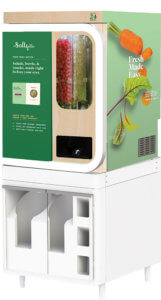
Americans waste enough food to fill a 90,000-seat stadium every day. he value of food wasted in the U.S. each year has been estimated at between $162–$218 billion. (Painting by Dennis Wojtkiewicz)
One of the biggest takeaways from the World Wildlife Fund’s (WWF) research into ending food waste in commercial kitchens — discussed in Convene’s November cover story, “Can Events Help Solve the Global Food Crisis?” — was the need to clearly better communicate with meeting planners about the multiple ways in which they could use their role to reduce food waste, said WWF’s Monica McBride.
Here are areas to address.
Request Measurement
Ask hotels, conference centers, and caterers (event managers) to separate and measure food waste, if possible, including what’s recoverable, reusable, or inedible from prep to post-service. Request a waste report that you can use to inform future planning. (See “Tech Solutions” below.)
Prevent When Possible
Ask hotel event sales staff for low-waste menu options and full-product utilization recipes. When possible, opt for plated meals rather than buffet, as a waste-avoidance option. Provide attendee data earlier and more frequently and explore ways to understand your event’s “eater profiles.”
Reexamine portion sizing and overset contract terms, as many contracts often include a built-in 3-percent overage that often leads to wasted food.
Donate Edible Surplus Food
Ask hotel event sales staff if they have active food- recovery programs with community partners. If your venue is not actively donating surplus food, ask to support a pilot program with recommended partners. Put food recovery plans into contract terms. Encourage awareness of the Bill Emerson Good Samaritan Food Donation Act. (See “Yes, You Can Donate Food” below.)
Divert Inedible Waste
Ask hotel event sales staff to divert unavoidable food waste (i.e., plate waste and food that has become no longer food safe) away from landfills to local composting or anaerobic digestion facilities, for example. Propose secondary donation options such as animal feed for scraps inedible for people.
Waste-Prevention Culture
Ask hotel event sales staff if they have a training program for food-waste education and practices for staff. Ask for signage on the buffet to encourage conscious consumption in line with the property’s food philosophy. Start an awareness campaign within your own organization to create a prevention culture.
Barbara Palmer is Convene‘s deputy editor.
These stories are part of Convene’s CMP Series, which enables readers to earn one hour of CE credit toward CMP certification from the Events Industry Council. Find the main story, “Can Events Help Solve the Global Food Crisis?” For access to additional CMP Series stories, go to CMP Series web page.
Yes, You Can Donate Food

Suzanne Morrell
“Bill Emerson.” Every event planner who’s ever gotten pushback from hotels about donating excess food should memorize that name and use it, advises Washington D.C.–based event planner Suzanne Morrell, founder of the D.C. Event Food Waste Coalition. The Bill Emerson Good Samaritan Food Donation Act is a federal law which protects businesses from liability when donating to a nonprofit organization, if certain conditions are met.
The law was passed in 1996, but only half of the hotel kitchen staff surveyed in 2017 by the World Wildlife Fund (WWF) were aware of the protection. Many hotels and kitchens are covered by additional local and state legislation designed to help them give excess food away to those in need.
The following conditions set by the Good Samaritan Act include:
- The food must be donated to a nonprofit organization in good faith, meaning that the food must be donated with the honest belief that it is safe to eat.
- The food must meet all federal, state, and local quality and labeling requirements, even if it is not readily marketable due to appearance, age, freshness, grade, size, surplus, or other conditions.
- The nonprofit organization that receives the donated food must distribute it to needy individuals without receiving funds.
- The end recipient must not pay anything of monetary value for the donated food.
— Barbara Palmer
RELATED: Moving the Needle on Food Donations

Sally the salad robot will be deployed at the Javits Center. (Courtesy Chowbotics)
Tech Solutions
At the Baltimore Convention Center (BCC), staff use a custom “food-recovery dashboard,” which allows them to track and collect data about what happens to the food produced for events, including reporting on meals consumed and the amount of food donated or used as animal feed, down to the ounce, said BCC Deputy Director Mac Campbell. Data analysis helps them make adjustments to the amount of food ordered and prepared, he said.
Other technology that is helping to win the fight against food waste include:
- An artificial intelligence–powered bin, called Winnow, uses a camera and smart scales to identify the types of food that are being discarded — information that can be used to guide decisions about production, menu planning, and the reuse of food items. After the system was put into use at Marriott’s Grosvenor House, a Luxury Collection Hotel, in Dubai last year, food waste was cut by 72 percent, according to Marco Torasso, the hotel’s culinary director.
- Cultivated, the recently relaunched food-and-beverage brand at New York City’s Javits Center, will make use of “Sally the Robot,” to prepare salads and other dishes. The robot, created by Chowbotics, reduces food waste by controlling food temperature and reducing the risk of spoilage.
- The Seattle-based startup WISErg has raised $70 million to produce a small-scale anaerobic digester designed to be used at restaurants, grocery stores, schools, hospitals, and other community centers. An average-sized unit can process 4,000 pounds of food scraps daily and eventually pays for itself given its sellable end-product: natural biogas, a clean, local renewable energy resource. (from The Fate of Food).
- The Massachusetts-based startup Harvest Power also has raised tens of millions of dollars to build composting technology, which it markets with the motto “VISUALIZE WHIRLED PEAS,” (from The Fate of Food).
— Barbara Palmer
